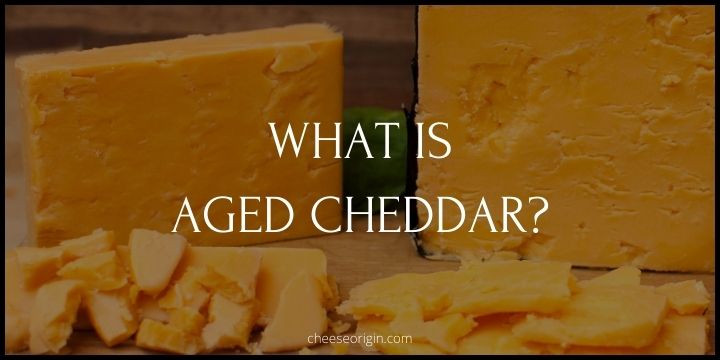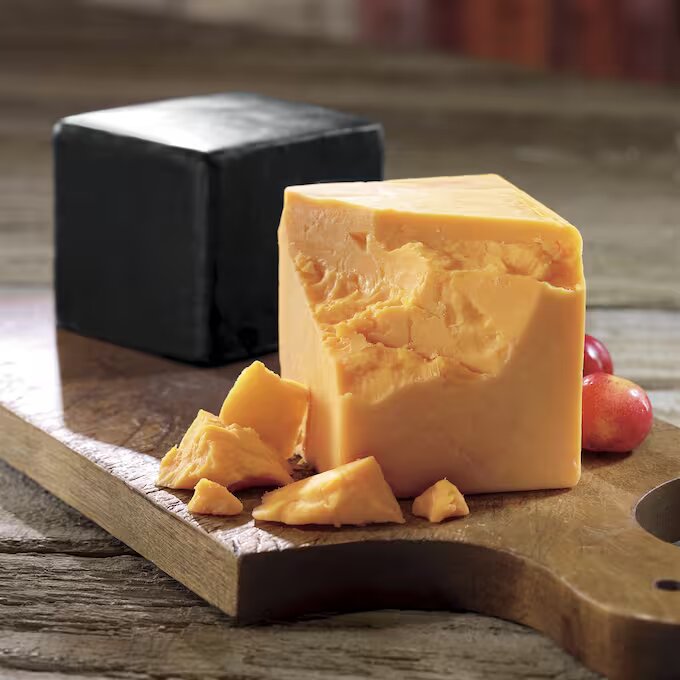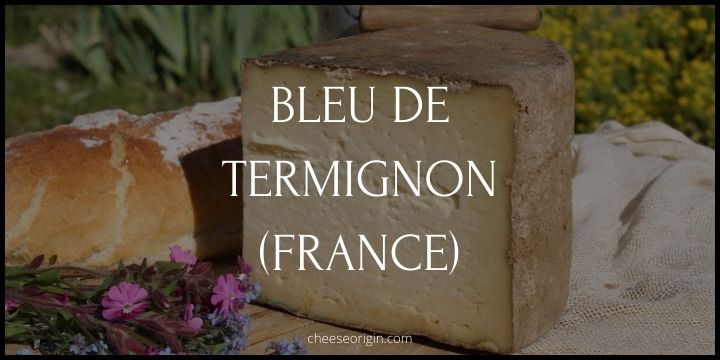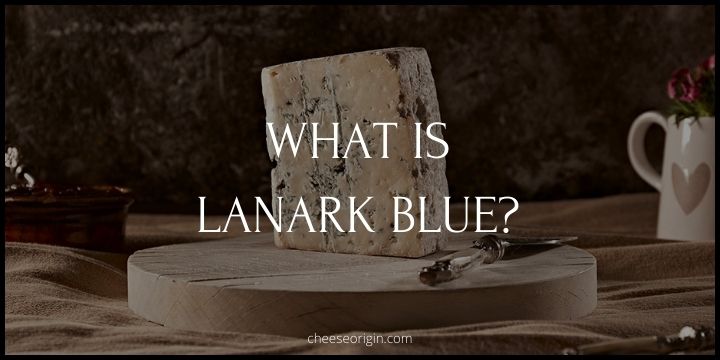What is Aged Cheddar? The Cheese That Stands the Test of Time

Aged Cheddar is a culinary delight that truly stands the test of time. As a dense, solid cow’s milk cheese, it’s known for its flaky texture and complex flavor profile that intensifies with age. Starting from as young as six months, Cheddar can be aged for several years, with some specialty varieties even reaching a maturity of 15 years or more.
The result? A cheese that evolves from a mild, creamy character into a strong, sharp, and sometimes nutty flavor powerhouse. This transformation is accompanied by a change in texture, turning from smooth and firm to granular and crumbly, marking a true journey of taste and texture.
Quick Facts About Aged Cheddar
| Quick Fact | Details |
|---|---|
| Origin | Originated in the English village of Cheddar in Somerset |
| Aging Process | Matured for 9 months to over 24 months |
| Flavor Profile | Strong, rich, and nutty flavor that intensifies as it ages |
| Texture | Firm and crumbly, with a slightly grainy texture |
| Color | Can range from white to pale yellow; darker cheddar has added colorant |
| Pairings | Pairs well with robust red wines, apples, pears, and hearty breads |
| Uses | Popular in sandwiches, macaroni and cheese, and as a snack on its own |
| Nutrition | High in protein and calcium, but also high in calories and fat |
| Storage | Best stored in wax or parchment paper, not plastic |
| Varieties | Comes in mild, medium, sharp, and extra sharp varieties based on aging |
What is Aged Cheddar?

Aged Cheddar, a culinary treasure with a rich history and an even richer flavor, is more than just a cheese – it’s an experience. Born in the picturesque village of Cheddar in Somerset, England, the journey of this cheese from a humble dairy product to a gourmet delight is a story of time, tradition, and craftsmanship.
The making of Aged Cheddar is a meticulous process that begins with curdling high-quality milk. The curd is then cut, heated, and pressed into molds to form large blocks or wheels. But the true transformation occurs during the aging process, which can span from 9 months up to 24 months or even longer. As the cheese matures, it develops a deep, complex flavor profile that is unmistakably unique. It grows stronger, richer, and nuttier with time, much like a fine wine.
In terms of appearance, Aged Cheddar can vary from a milky white to a pale yellow color. Some variants may have added colorants for a deeper shade. The texture is firm yet slightly crumbly, with a characteristic graininess that comes from its extended maturation period.
Aged Cheddar is a star in the culinary world, featuring in everything from gourmet sandwiches to comforting bowls of macaroni and cheese. It pairs beautifully with robust red wines, crisp apples, pears, and hearty breads, making it a staple on cheese boards. However, it’s also perfect for savoring on its own, allowing one to fully appreciate the depth of its flavor and the subtleties of its texture.
From a nutritional standpoint, Aged Cheddar packs a punch. It’s high in protein and calcium, offering significant benefits. However, it’s also high in calories and fat, so moderation is key. But when it comes to cheese as delicious as Aged Cheddar, resisting the temptation to indulge can be a challenge in itself!
What Does Aged Cheddar Taste Like
Aged Cheddar is a symphony of flavors that unfolds in layers. It has a strong and robust taste that becomes more pronounced as the cheese matures. The initial flavor profile is rich and creamy, with a slight hint of bitterness. As the cheese ages, it develops a deeper, more complex character, exuding nutty and earthy notes.
The aging process also imparts a certain sharpness to the cheese, giving it a bold and tangy edge. However, this sharpness is beautifully balanced by the underlying creaminess of the cheese, creating a harmonious blend of flavors.
In terms of texture, Aged Cheddar is firm and slightly crumbly, which further enhances its taste. It has a unique graininess that is a result of the calcium lactate crystals formed during the long aging process. These crystals add a subtle crunch and a burst of intense flavor, making the experience of eating Aged Cheddar truly unique and enjoyable.
Overall, Aged Cheddar offers a complex, rich, and intense flavor journey that is both satisfying and memorable. It’s a cheese that commands your attention and lingers on your palate, leaving you wanting more.
Aged Cheddar Tasting Notes
- Appearance: Aged Cheddar typically ranges in color from a creamy white to a pale or deep yellow. It’s firm yet slightly crumbly in texture, with visible graininess due to the formation of calcium lactate crystals during maturation.
- Aroma: Aged Cheddar has a distinct aroma that is rich and inviting. It exudes a slight tangy smell with undertones of fresh cream and earthiness. The scent becomes more pronounced as the cheese ages.
- Flavor Profile: The flavor of Aged Cheddar is robust and complex. It starts off with a rich, creamy taste, followed by a hint of bitterness. As the cheese matures, it develops nutty and earthy notes. The taste is bold and tangy, with a balanced sharpness that is characteristic of aged cheeses.
- Texture: The texture of Aged Cheddar is one of its unique aspects. It’s firm but not hard, with a slight crumble that adds to its charm. The presence of small, crunchy calcium lactate crystals formed during the aging process offers a delightful surprise in every bite.
- Aftertaste: Aged Cheddar leaves a lingering aftertaste that is as complex as its initial flavor. It’s rich, nutty, and slightly salty, with a lasting creaminess that invites you to take another bite.
How to Eat Aged Cheddar?
- Savor it Solo: One of the best ways to appreciate the complex flavor profile of Aged Cheddar is to enjoy it on its own. Let a small piece melt in your mouth and savor the symphony of flavors.
- Cheese Board Classic: Include Aged Cheddar on a cheese board along with other varieties of cheese for a delightful contrast of flavors. Pair it with fruits like apples, pears, and grapes, as well as nuts, olives, and cured meats.
- Wine Pairing: Aged Cheddar pairs beautifully with robust wines. Try it with a full-bodied Cabernet Sauvignon or a rich Merlot to enhance its flavor.
- Sandwich Star: Use slices of Aged Cheddar in sandwiches for a gourmet twist. Its robust flavor can elevate even the simplest sandwich.
- Cooking Companion: Incorporate Aged Cheddar into dishes like macaroni and cheese, quiches, and gratins. Its rich flavor adds depth to these dishes.
- Grate and Garnish: Grate Aged Cheddar over salads, soups, and pastas for a flavorful garnish. The heat from the dish will slightly melt the cheese, releasing its exquisite flavors.
- Breakfast Buddy: Add Aged Cheddar to your breakfast by including it in omelets or pairing it with bread and jam. Its bold flavor is a great way to kickstart your day.
- Cheddar and Chocolate: For an adventurous palate, pair Aged Cheddar with dark chocolate. The creaminess of the cheese complements the bitterness of the chocolate, creating a unique and delicious flavor combination.
What is the Difference Between Aged Cheddar and Classic Cheddar?
The primary difference between aged Cheddar and classic (or young) Cheddar is the length of time they are aged and the resulting changes in flavor, texture, and color.
| Characteristic | Aged Cheddar | Classic Cheddar |
|---|---|---|
| Aging Process and Time Period | Matured over a long period, typically more than a year. Some can even be aged up to 10 years. | Aged for a shorter period, around 2 to 3 months. |
| Flavor | Has a strong, sharp, and robust flavor. The taste becomes progressively intense as the cheese matures. Some very aged Cheddars can even develop a slightly nutty or caramel-like flavor. | Has a milder, creamier taste. It’s less complex compared to its aged counterpart. |
| Texture | Harder and more crumbly due to the evaporation of moisture over time. May also have crystalline textures, which are considered desirable and add a crunchy element. | Softer, smoother, and more pliable because it retains more moisture. It’s easier to slice without crumbling. |
| Color | The color often deepens with age, becoming darker and more intense. However, the exact color can vary depending on the cheese-making process. | Generally has a lighter color, ranging from white to pale yellow. |
| Price | Due to the longer aging process and storage costs, aged Cheddar is generally more expensive than classic Cheddar. | Typically less expensive because it matures for a shorter time and requires fewer resources to produce. |
| Usage | Its strong flavor makes it great for savoring on its own or pairing with robust wines. It’s also used in recipes where a bold cheese flavor is desired. | Its mild flavor makes it versatile for cooking and baking. It’s also great for sandwiches, cheeseburgers, and other dishes where a milder cheese flavor is desired. |
>> Click here to read our in-depth guide on Classic Cheddar
10 Best Aged Cheddar Substitutes
| Substitute | Description |
|---|---|
| Gouda | This Dutch cheese is semi-hard and has a rich, unique flavor. Aged Gouda can be a good substitute for Aged Cheddar in terms of texture and taste. |
| Colby | An American cheese that’s similar to Cheddar but milder in flavor. It’s less tangy and more creamy, making it a good alternative for those who prefer a softer taste. |
| Monterey Jack | Another mild cheese that melts well. It can replace Aged Cheddar in cooking recipes where the cheese needs to melt smoothly. |
| Emmental | A Swiss cheese with a slightly sweet and nutty flavor. It’s softer than Aged Cheddar but can work well in recipes requiring a mild cheese flavor. |
| Jarlsberg | A Norwegian cheese that’s sweet and nutty, similar to Swiss cheese but with a stronger flavor. It’s a good substitute in sandwiches or cheese platters. |
| Swiss Cheese | Known for its distinctive holes, Swiss cheese has a mild, nutty flavor. It can be used as a replacement for Aged Cheddar in many dishes. |
| Provolone | An Italian cheese that’s semi-hard and has a smooth, tangy flavor. It can replace Aged Cheddar in sandwiches or melted cheese dishes. |
| Parmesan | A hard, granular cheese that’s flavorful and savory. It can be grated over dishes as an alternative to Aged Cheddar. |
| Manchego | A Spanish cheese that’s firm and compact. It has a distinctive flavor that can stand up to the strong taste of Aged Cheddar. |
| Romano | Another hard, Italian cheese with a strong, salty flavor. It’s a good substitute for Aged Cheddar in recipes requiring a bold cheese flavor. |
What Pairs Well With Aged Cheddar?

Food that goes well with Aged Cheddar:
| Category | Food |
|---|---|
| Fruits | Apples, Pears, Grapes, Figs, Dried Apricots |
| Nuts | Almonds, Walnuts, Pecans, Cashews |
| Breads | Sourdough, Baguette, Whole Wheat Bread, Rye Bread, Crackers |
| Meats | Salami, Prosciutto, Smoked Turkey, Roast Beef |
| Condiments | Honey, Fig Jam, Apple Butter, Mustard |
| Vegetables | Pickles, Olives, Sun-dried Tomatoes, Roasted Red Peppers |
| Other Cheeses | Brie, Gorgonzola, Camembert, Goat Cheese |
| Sweets | Dark Chocolate, Caramel, Fruit Preserves |
| Grains | Quinoa, Brown Rice, Whole Grain Pasta |
| Seafood | Smoked Salmon, Anchovies |
| Herbs and Spices | Rosemary, Thyme, Black Pepper, Paprika |
Also read: What Fruit Goes on a Charcuterie Board?
Beverage that goes well with Aged Cheddar:
| Category | Beverage |
|---|---|
| Wine | Cabernet Sauvignon, Merlot, Chardonnay, Port |
| Beer | Stout, Brown Ale, IPA (Indian Pale Ale), Amber Ale |
| Whiskey | Bourbon, Scotch, Rye Whiskey |
| Non-Alcoholic Drinks | Apple Cider, Grape Juice, Cranberry Juice, Herbal Tea |
| Cocktails | Old Fashioned, Manhattan, Negroni |
| Coffee | Espresso, French Press, Cold Brew |
| Tea | Earl Grey, English Breakfast, Green Tea |
| Spirits | Brandy, Rum, Tequila |
| Liqueurs | Amaretto, Baileys Irish Cream, Grand Marnier |
| Ciders | Traditional Apple Cider, Pear Cider, Spiced Cider |
Also read: Best Wine and Cheese Pairings: The Ultimate Guide
Frequently Asked Questions
1. Will Aged Cheddar melt?
Yes, aged cheddar will melt, but it might not melt as smoothly as younger, softer cheeses. The aging process reduces the moisture content in the cheese, making it drier and more crumbly. This can cause it to separate or become a bit grainy when melted. However, it still can be used in cooking and will provide a rich, deep flavor to dishes.
2. Is Aged Cheddar hard or soft?
Aged Cheddar is considered a hard cheese. As Cheddar cheese is aged, it loses moisture and becomes harder, more crumbly, and more intense in flavor. The aging process can range from a few months to several years. The longer the cheese is aged, the harder and more flavorful it becomes. So, an aged Cheddar will be harder and more crumbly than a young Cheddar.
Also read:
- What is Mizithra? Greece’s Gift to the Cheese World
- What is Goat Brie? A Unique Twist on a Classic Cheese
- What is Cambozola? Germany’s Unique Hybrid Cheese
- What is Crema Mexicana? The Creamy Crown of Mexican Cuisine
- What is Red Leicester? The Ruby of English Cheeses
- What is Wensleydale? From Monks to Modern Creameries
- What is Truffle Cheese? Savoring the Richness




